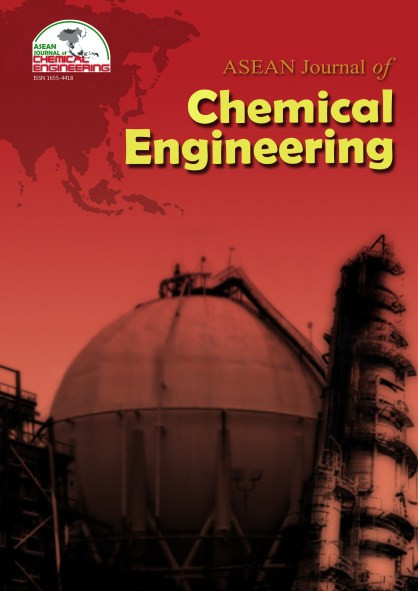Assessment of Aqueous Lithium-based Salt Solutions as Working Fluid for Absorption Chillers using Aspen Plus
Abstract
Absorption chillers are a viable option for providing waste heat-powered cooling or refrigeration, thereby improving overall energy efficiency-less primary energy input, lower emissions, and cost savings. This study focuses on the assessment of aqueous lithium-based salt solutions as working fluid for absorption chiller in exploring the possibility of developing new mixtures for absorption chillers to improve the performance of the absorption refrigeration systems (ARSs). In this paper, the coefficient of performance (COP) of a single effect absorption chiller using aqueous lithium-based salt solutions (LiF-H2O, LiCl-H2O, LiBr-H2O, and LiI-H2O) as working fluid was assessed using Aspen Plus®. The simulation results obtained showed that the mass and energy were well balanced for all systems. Furthermore, a direct proportionality relationship between COP of absorption chillers and the van't Hoff factor, i of dissociated aqueous salt solutions was observed. The highest COP value is 0.8930 for LiI-H2O among others.
References
2. Aspen Plus®, Version 2006, Aspen Technology Inc., 200 Wheeler Road Burlington, MA, USA.
3. Florides, G., S. Kalogirou, S. Tassou, and L. Wrobel (2002). “Modelling and simulation of an absorption solar cooling system for Cyprus”. Solar Energy, 72, 43-51.
4. Gebreslassie, B., G. Guillén-Gosálbez, L. Jiménez, and D. Boer (2009). “Design of environmentally conscious absorption cooling systems via multi-objective optimization and life cycle assessment”. Appl. Energy, 86, 1712-1722.
5. Hufford, P. (1992). “Absorption chillers improve cogeneration energy efficiency”. ASHRAE Journal, 34, 46-53.
6. Leron, G. M., A. P. Adornado, D. G. Zalvidea, L. P. Gutierrez, S. W. B. Suarez, A. N. Soriano, and M.-H. Li (2014). Selection of single and blended aqueous alkanolamine for post- combustion carbon dioxide capture using rate-based non-equilibrium process simulation. PIChE Journal, Vol. 15 (1).
7. Maidment, G. and R. Tozer (2002). “Combined cooling heating and power in supermarkets”. Appl. Therm. Eng., 22, 653-665.
8. Moné, C., D. Chau, and P. Phelan (2001). “Economic feasibility of combined heat and power and absorption refrigeration with commercially available gas turbines”. Energ. Convers. Manage., 42, 1559-1573.
9. Nieva, A. D., F. C. De Vera, A. P. Adornado, B. P. Gallarte, and B. T. Doma Jr. (2016). “Simulation of biosorption of lead and copper with Pinus insularis using Aspen Adsorption®”. PIChE Journal, Vol. 16 (1).
10. Sieres, J., J. Fernandez-Seara, and F. Uhia (2009). “Experimental characterization of the rectification process in ammonia-water absorption systems with a large-specific-area corrugated sheet structured packing”. Int. J. Refrig., 32, 1230-1240.
11. Somers, C., A. Mortazavi, Y. Hwang, R. Radermacher, P. Rodgers, and S. Al- Hashimi (2011). “Modeling water/lithium bromide absorption chillers in ASPEN Plus”. Appl. Energy, 88, 4197-4205.
12. Soriano, A. N., A. P. Adornado, A. A. Pajinag, D. J. F. Acosta, N. M. Averion, G. M. Leron, and V. C. Bungay (2015). “Multicriterial analysis of simulated process of post-combustion capture of pure H2S and mixtures of H2S and CO2 using single and blended aqueous alkanolamines”. AJChE, 1, 72-92.
13. Sumathy, K., Z. Huang, and Z. Li (2002). “Solar absorption cooling with low grade heat source-a strategy of development in South China”. Solar Energy, 72, 155-165.
14. Tremblay, D., S. Watanasiri, Y. Song, and C.-C. Chen (2010). “Benefits of the new electrolyte models in Aspen Plus® version 7.2”. Best in Class Electrolyte Thermodynamics. Aspen Technology Incorporated, Ten Canal, Cambridge, U. S. A.
Copyright holder for articles is ASEAN Journal of Chemical Engineering. Articles published in ASEAN J. Chem. Eng. are distributed under a Creative Commons Attribution-NonCommercial 4.0 International (CC BY-NC 4.0) license.
Authors agree to transfer all copyright rights in and to the above work to the ASEAN Journal of Chemical Engineering Editorial Board so that the Editorial Board shall have the right to publish the work for non-profit use in any media or form. In return, authors retain: (1) all proprietary rights other than copyright; (2) re-use of all or part of the above paper in their other work; (3) right to reproduce or authorize others to reproduce the above paper for authors’ personal use or for company use if the source and the journal copyright notice is indicated, and if the reproduction is not made for the purpose of sale.



